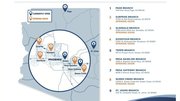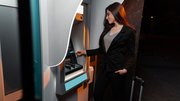News
Driving the brand outside the branch
'It's far cheaper to put up ATMs and operate them than it is to open a branch on every corner,' said Michael Armbruster, senior vice president and CIO of $2.7 billion ESL Federal Credit Union, which has installed 14 drive-up ATMs in just over a year and has plans for one more before year's end.
November 14, 2004
Installing drive-up ATMs is not an inexpensive proposition -- especially in a non-branch environment where financial institutions generally incur added costs for communications and electrical lines.
Offers the best in reliable ATM equipment, courteous customer service, and revenue-generating programs so owning an ATM is easy and profitable.  |
But an investment of tens or even hundreds of thousands of dollars appears downright economical when compared to the millions of dollars required to build a full branch.
"It's far cheaper to put up ATMs and operate them than it is to open a branch on every corner," said Michael Armbruster, senior vice president and CIO of $2.7 billion ESL Federal Credit Union, which has installed 14 drive-up ATMs in just over a year and has plans for one more before year's end.
The brand's the thing
ESL's drive-ups provide more branding bang for the buck than its other non-branch ATMs, Armbruster said.
"There was just no other way for us to get our brand out there to the degree we wanted," he said, joking, "No store in its right mind would let us give the ESL brand that kind of prominence."Non-branch drive-ups are not a common option for FIs and are used most often by smaller community banks and credit unions, said Al Tiley, CEO of enclosure manufacturer Companion Systems.
"Larger banks don't tend to do (drive-ups) as much because they have a more extensive branch network. But smaller FIs can use them to extend their brand beyond the confines of the branch and to offer more convenience for their clients," Tiley said.
Joseph Piendel, a product manager at ESL, said that some new customers have cited the drive-up ATMs, most of which have depositories, as a reason they opened accounts with ESL.
Most FIs will spend $15,000 to $25,000 for enclosures to house non-branch drive-ups, Tiley said. While they can cut costs at branches by piggybacking electrical and communications lines on existing systems, that option generally does not exist at non-branch sites.
About a third of ESL's 95 ATMs are standalone drive-ups in non-branch locations. Most of the sites include two machines, Armbruster said, to reduce the possibility of idling cars lined up to use ATMs and to ensure that at least one machine is always up and running.
Another third are located at branches, which are typically outfitted with one machine in the lobby and two in drive-through lanes; the rest of are in corporate and retail locations.
Transactions on us
Armbruster said ESL took particular care with site selection, evaluating its members' foreign ATM transactions to determine where they used ATMs most -- and ended up paying fees. Following the installation of the drive-ups, ESL's percentage of "on-us" transactions rose from roughly 45 percent in 2002 to 60 percent today.
About 40 percent of ESL's total ATM transactions are performed at the non-branch drive-ups, with its busiest machines generating in excess of 15,000 transactions a month. Drive-ups are especially popular in ESL's home of upstate New York because of the inclement weather, Armbruster said.
Setting up the sites
 |
$2.7 billion ESL Federal Credit Union has installed 14 drive-up ATMs like this in just over a year and has plans for one more before year's end. |
ESL's original plan was to deploy 20 non-branch drive-ups in a year. Armbruster said it took closer to two years to install 14 ATMs, largely because of difficulties in obtaining approval from each municipality. "They all had a different pet peeve or issue, and it seemed like it was a different one each time."
It was generally important for the drive-ups to aesthetically blend into their surroundings, which sometimes required tweaks of ESL's preferred look. "It was important to us to keep our brand consistent, but we also had to make sure the neighborhood liked it," Armbruster said.
"What we considered a little thing would sometimes become a big thing," Piendel said. For instance, ESL had to ensure that lighting met New York's security standards without disturbing neighbors.
In a few instances, ESL encountered environmental issues, most notably at the site of a former gas station. The FI had been assured that toxins had been removed from the area -- but discovered that wasn't the case when digging began. "We ended up hauling off a lot of contaminated soil," Piendel said.
Both men agreed that the occasional travails were worth it. "It was a lot of work, but now that we have them out there, it feels really good," Armbruster said.
In 2005, ESL intends to use NCR's Aptra Edge software to add one-to-one marketing capabilities to its ATMs, including the non-branch drive-ups. It anticipates a high take rate among its members because of its Siebel CRM system, which has been used in branches for more than 18 months.
It will first have to upgrade its ATMs, which already communicate with IP connections via a frame relay network, to a Microsoft Windows operating system.
















